Exercise Forging Sabre: What it takes to be a Singaporean sniper
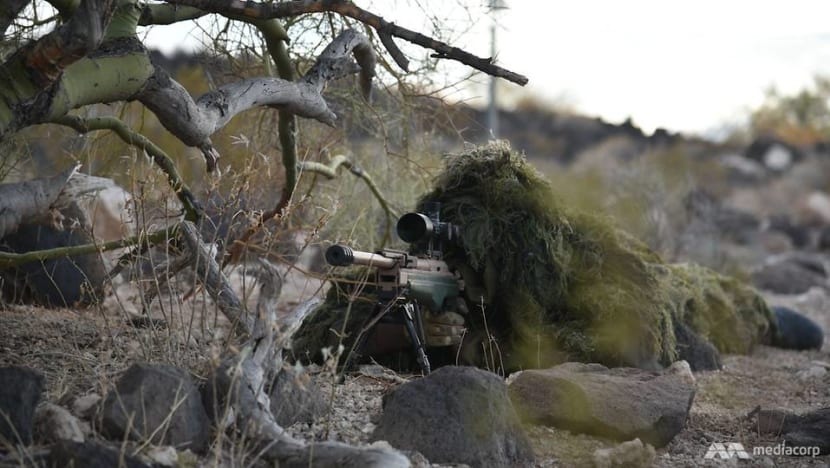
A Commando on the TRG-22 and kitted in a ghillie suit, the only photo we were allowed to take of the elite sharpshooters. (Photo: Aqil Haziq Mahmud)
PHOENIX: At first, it was just no photos.
A day before I travelled deep into the Arizona desert to meet a bunch of Singapore Armed Forces (SAF) Commandos and try firing one of their sniper rifles, I was told no interviews too.
I knew they were an elite force, so when a group of reporters including myself got the chance to get up close and personal, there certainly was some level of anticipation. The restricted access added to the intrigue.
The sniper rifle-wielding Commandos – I was carefully told not to call them snipers – were participating in Exercise Forging Sabre, held in Arizona this week. These Commandos were only a small component of the exercise, tasked with completing ambush missions.
The journey to where they were stationed did not disappoint. I loaded up into a large Chevvy SUV, driven by army maintenance personnel, and was taken into some of the emptiest stretches of land I have ever witnessed.
There were no paved roads, just sandy trails pockmarked with potholes where the sand gave way. Seatbelts please, I was warned. The SUV rocked and tilted, but there was no motion sickness, because the views were stunning: Rocky hills gently rising against endless ribbons of clear, blue skies.
My destination was the top of a rather steep hill, but the gradient was no match for the powerful SUV. The driver threw the vehicle into low gear and it lurched up the hill, winding around it for more gorgeous 360-degree scenery.

The Commandos were already waiting when I arrived at a makeshift car park on the summit, and the one who was going to conduct the briefing especially looked the part.
His chest muscles and biceps bulged against his Number 4 fatigue. The left chest was adorned with airborne, freefall and combat diving badges. On the left sleeve: the Ranger and Special Forces tabs. Basically, he was a walking signboard that read: “Don’t mess with me".
The Commando spoke in short, sharp sentences about the two long-range rifles we were going to try out: the Knight's Armament M110 and Sako TRG-22.
The M110, an American make, can fire off multiple rounds without the need to cock the weapon between rounds. Because it can engage faster, it is used for covering troops in built-up areas.
The TRG-22, a Finnish weapon, comes in camouflage colours and has a longer barrel, meaning it can hit a target farther away. It is slightly slower because it has to be cocked after every round. What’s special is its foldable butt stock, which makes it more portable. The TRG-22 is used for field firing, which includes stalking enemy targets.
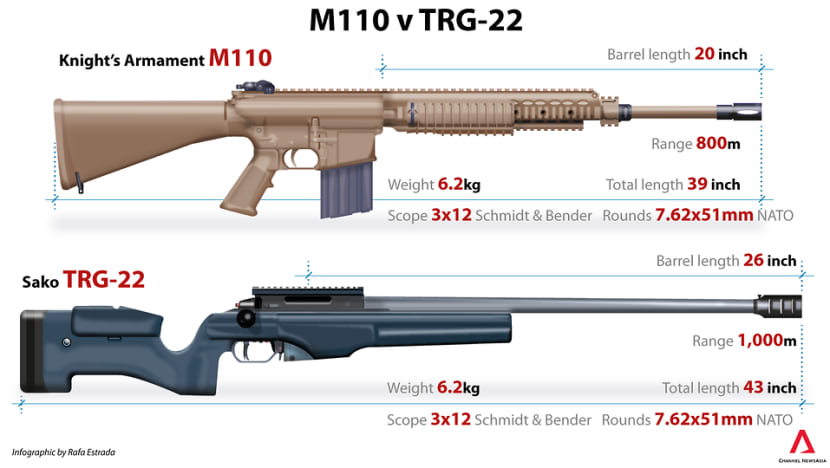
The two rifles have been around in the SAF for about four years. Since they replaced older-generation weapons like the SR-25 and AWMP, they have made frequent appearances at the army open house back home.
Briefing time ended. We could try both rifles and fire two rounds each. I felt my stomach clench. Someone had told me the recoil was so powerful that it could dislocate shoulders.
But the recoil turned out to be rather tame. The rifles were not that loud either: Probably only as loud as the cookie-cutter SAR 21, if not softer. They could still be fitted with silencers. Nevertheless, the rifles were still not easy to use, as I found out.
The TRG-22 was up first. Another Commando supervised me as I lay prone on the sand, which was littered with thorny bushes and an assortment of pebbles. It was nothing like the ranges we train at in Singapore. I found a comfortable position and peered into the scope from my vantage point up the hill. Now it was a case of actually finding the target.
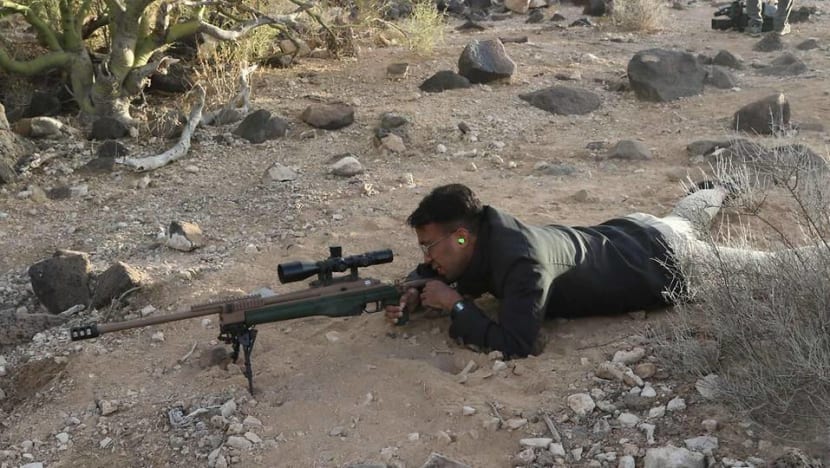
Here came the most difficult part. Because the target was so far away, a slight over-adjustment made my crosshair lose the target completely. Rocks under your hip? Too bad. Hold still or you will miss the target. If you don't see a full circle through your adjustable scope, that means your aiming is off too.
The targets were rectangular metal plates located hundreds of metres away. Amid all the brown, a slice of silver was not easy to spot. The Commando was extremely patient. After a few more minutes of fumbling around, I managed to get eyes on target.
My “lazy eye” condition means I rely heavily on my stronger left eye. Aiming is usually done with the right eye, which was bad news for me at every rifle range exercise back in National Service. People have suggested wearing an eye patch, but that seemed to make it worse.
Crosshair barely staying put, I pulled the trigger. There was no metallic clink. Target missed. I cocked the rifle and tried again. Another miss. The Commando chuckled and reassured me. I thanked him and dusted off my jacket, which had turned a light shade of brown.
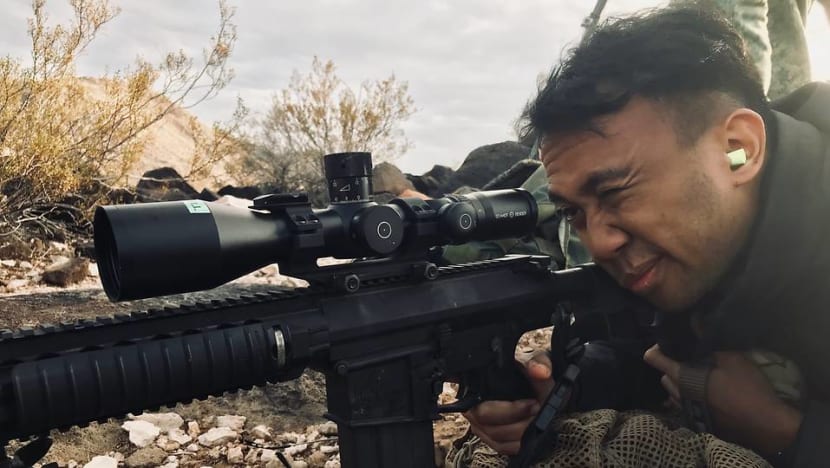
The M110 was slightly more comfortable to use because it felt sturdier and no cocking was involved. I still missed on both tries, however. Another career option crossed off the list then.
So what does it really take to be a good marksman?
Patience, field knowledge and wit, I learnt. Especially patience, because snipers have to spend a fair amount of time finding their target while camouflaging themselves to perfection. Having good eyesight is not a must, because the scope, which can make an object appear three times closer, solves that. Colour blindness is a problem, though.
The elements play a huge role too. We fired on a clear, windless day: Perfect conditions for sniping. But when there is wind, snipers have to factor that into their calculations. Sometimes, they fire at a spot as much as 1m away from the target to compensate.
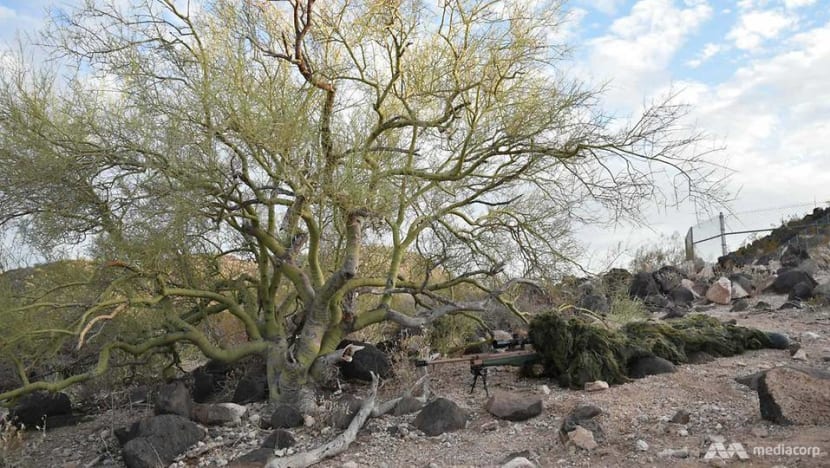
While snipers deployed in real-life war zones sometimes have running games like who has the most kills, Commandos here focus on who can hit the target on the first shot, or in the least amount of shots. It is all about getting it on the first hit, I discovered. Missing the first try means giving away your position, or causing the enemy to run and hide.
Near me, a Commando rapidly fired off multiple rounds with the M110. Silence, then clink, clink, clink.














